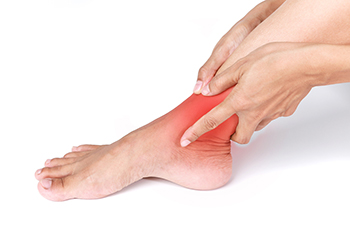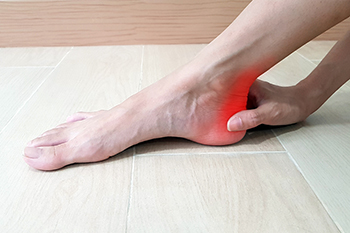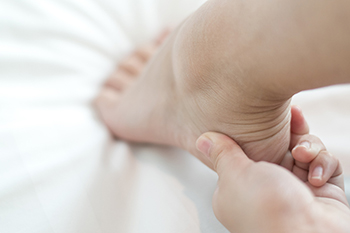Connect With Us
Items filtered by date: March 2022
What Is Tarsal Tunnel Syndrome?
 If you feel numbness, pins and needles, or pain in the bottom of your foot, you may have a condition known as tarsal tunnel syndrome. These symptoms may also extend to the toes and heel. The cause is likely to be an obstruction under the band of tissue that attaches the inner ankle to the heel and forms the tarsal tunnel. A number of blood vessels and tendons, along with the tibial nerve, pass through the tunnel. Pressure on the posterior tibial nerve may be caused by excess fluid following an ankle injury, fallen arches, footwear that is too tight, obesity, cysts, or bone spurs. A podiatrist can help determine the exact cause of the pain and offer treatment options such as steroid injections, orthotics, and/or braces. In some cases, surgery is necessary. It is a good idea to consult a podiatrist for an examination and diagnosis.
If you feel numbness, pins and needles, or pain in the bottom of your foot, you may have a condition known as tarsal tunnel syndrome. These symptoms may also extend to the toes and heel. The cause is likely to be an obstruction under the band of tissue that attaches the inner ankle to the heel and forms the tarsal tunnel. A number of blood vessels and tendons, along with the tibial nerve, pass through the tunnel. Pressure on the posterior tibial nerve may be caused by excess fluid following an ankle injury, fallen arches, footwear that is too tight, obesity, cysts, or bone spurs. A podiatrist can help determine the exact cause of the pain and offer treatment options such as steroid injections, orthotics, and/or braces. In some cases, surgery is necessary. It is a good idea to consult a podiatrist for an examination and diagnosis.
Tarsal tunnel syndrome can be very uncomfortable to live with. If you are experiencing tarsal tunnel syndrome, contact Ali Davis, DPM of The Foot Clinic. Our doctor can provide the care you need to keep you pain-free and on your feet.
Tarsal Tunnel Syndrome
Tarsal tunnel syndrome, which can also be called tibial nerve dysfunction, is an uncommon condition of misfiring peripheral nerves in the foot. The tibial nerve is the peripheral nerve in the leg responsible for sensation and movement of the foot and calf muscles. In tarsal tunnel syndrome, the tibial nerve is damaged, causing problems with movement and feeling in the foot of the affected leg.
Common Cause of Tarsal Tunnel Syndrome
- Involves pressure or an injury, direct pressure on the tibial nerve for an extended period of time, sometimes caused by other body structures close by or near the knee.
- Diseases that damage nerves, including diabetes, may cause tarsal tunnel syndrome.
- At times, tarsal tunnel syndrome can appear without an obvious cause in some cases.
The Effects of Tarsal Tunnel Syndrome
- Different sensations, an afflicted person may experience pain, tingling, burning or other unusual sensations in the foot of the affected leg.
- The foot muscles, toes and ankle become weaker, and curling your toes or flexing your foot can become difficult.
- If condition worsens, infections and ulcers may develop on the foot that is experiencing the syndrome.
A physical exam of the leg can help identify the presence of tarsal tunnel syndrome. Medical tests, such as a nerve biopsy, are also used to diagnose the condition. Patients may receive physical therapy and prescriptive medication. In extreme cases, some may require surgery.
If you have any questions please feel free to contact our office located in Overland Park, KS . We offer the newest diagnostic and treatment technologies for all your foot and ankle needs.
When the Back of Your Heel Is Painful
Pain behind the heel, known as posterior heel pain, can be caused by several conditions. Achilles’ tendonitis is an inflammation of the tendon that attaches to the back of the heel. The inflammation may be caused by tears or calcium deposits within the tendon. A bone spur that develops at the back of the heel bone (nicknamed “pump bump”) can irritate surrounding tissue and become painful rubbing against footwear. Retrocalcaneal bursitis is an inflammation of the cushioning bursa sac between the back of the heel and the Achilles tendon. Other possible causes of posterior heel pain include stress fractures in the heel bone, an inflammation of the plantar fascia tissue on the sole of the foot (plantar fasciitis), and compression and inflammation of a small, extra bone some people have in their ankle (os trigonum syndrome). If you have any pain in the back of your heel, it is suggested that you get your condition diagnosed and treated by a podiatrist.
Many people suffer from bouts of heel pain. For more information, contact Ali Davis, DPM of The Foot Clinic. Our doctor can provide the care you need to keep you pain-free and on your feet.
Causes of Heel Pain
Heel pain is often associated with plantar fasciitis. The plantar fascia is a band of tissues that extends along the bottom of the foot. A rip or tear in this ligament can cause inflammation of the tissue.
Achilles tendonitis is another cause of heel pain. Inflammation of the Achilles tendon will cause pain from fractures and muscle tearing. Lack of flexibility is also another symptom.
Heel spurs are another cause of pain. When the tissues of the plantar fascia undergo a great deal of stress, it can lead to ligament separation from the heel bone, causing heel spurs.
Why Might Heel Pain Occur?
- Wearing ill-fitting shoes
- Wearing non-supportive shoes
- Weight change
- Excessive running
Treatments
Heel pain should be treated as soon as possible for immediate results. Keeping your feet in a stress-free environment will help. If you suffer from Achilles tendonitis or plantar fasciitis, applying ice will reduce the swelling. Stretching before an exercise like running will help the muscles. Using all these tips will help make heel pain a condition of the past.
If you have any questions please contact our office located in Overland Park, KS . We offer the newest diagnostic and treatment technologies for all your foot and ankle needs.
How to Choose Your Child’s Shoes
 Your child’s feet will grow very quickly in the first 5 years of their life. Proper footwear during this time is very important in order to allow the bones in the feet to grow straight. When your child is just a baby, the bones in the toes are very soft, and shoes and socks that are too tight can restrict these bones from growing properly. In fact, shoes are not necessary for children until they are walking on their own, and even then, they are only needed for walking outside. It is important to also make sure that your child’s shoes are fastened with either laces or Velcro in order to keep the heel from slipping out of the shoe. Parents who have further questions about what shoes their child should be wearing as they grow can consult with a podiatrist for further advice and recommendations.
Your child’s feet will grow very quickly in the first 5 years of their life. Proper footwear during this time is very important in order to allow the bones in the feet to grow straight. When your child is just a baby, the bones in the toes are very soft, and shoes and socks that are too tight can restrict these bones from growing properly. In fact, shoes are not necessary for children until they are walking on their own, and even then, they are only needed for walking outside. It is important to also make sure that your child’s shoes are fastened with either laces or Velcro in order to keep the heel from slipping out of the shoe. Parents who have further questions about what shoes their child should be wearing as they grow can consult with a podiatrist for further advice and recommendations.
Making sure that your children maintain good foot health is very important as they grow. If you have any questions, contact Ali Davis, DPM of The Foot Clinic. Our doctor can provide the care you need to keep you pain-free and on your feet.
Keeping Children's Feet Healthy
Having healthy feet during childhood can help prevent medical problems later in life, namely in the back and legs. As children grow, their feet require different types of care. Here are some things to consider...
Although babies do not walk yet, it is still very important to take care of their feet.
Avoid putting tight shoes or socks on his or her feet.
Allow the baby to stretch and kick his or her feet to feel comfortable.
As a toddler, kids are now on the move and begin to develop differently. At this age, toddlers are getting a feel for walking, so don’t be alarmed if your toddler is unsteady or ‘walks funny’.
As your child gets older, it is important to teach them how to take care of their feet.
Show them proper hygiene to prevent infections such as fungus.
Be watchful for any pain or injury.
Have all injuries checked by a doctor as soon as possible.
Comfortable, protective shoes should always be worn, especially at play.
If you have any questions please feel free to contact our office located in Overland Park, KS . We offer the newest diagnostic and treatment technologies for all your foot and ankle needs.
Reminder: When Was the Last Time...?
Your Ankle Pain May Be Caused by a Ganglion Cyst
 A ganglion cyst is a benign, fluid-filled mass that develops near a joint capsule or the thin layer of tissue surrounding a tendon. When ganglion cysts develop in the feet, they can occur in the ankle or top of the foot. Ganglion cysts usually present as a visible lump on the outside of the skin, and can cause a dull ache or pain—especially if the cyst is pressing on a joint or tendon, or is being irritated by footwear. In some cases, a ganglion cyst may be caused by some sort of trauma, however the exact cause of these bothersome growths is not always known. Because ganglion cysts sometimes disappear on their own, your podiatrist may determine that monitoring the cyst for a period of time may be the best initial approach. However, if the pain and discomfort are severe, or you have had the cyst for a while, your podiatrist may suggest other treatments such as modifications to footwear, aspirating the cyst and injecting it with steroids, or even surgery if more conservative treatment options don't provide relief or the cyst returns.
A ganglion cyst is a benign, fluid-filled mass that develops near a joint capsule or the thin layer of tissue surrounding a tendon. When ganglion cysts develop in the feet, they can occur in the ankle or top of the foot. Ganglion cysts usually present as a visible lump on the outside of the skin, and can cause a dull ache or pain—especially if the cyst is pressing on a joint or tendon, or is being irritated by footwear. In some cases, a ganglion cyst may be caused by some sort of trauma, however the exact cause of these bothersome growths is not always known. Because ganglion cysts sometimes disappear on their own, your podiatrist may determine that monitoring the cyst for a period of time may be the best initial approach. However, if the pain and discomfort are severe, or you have had the cyst for a while, your podiatrist may suggest other treatments such as modifications to footwear, aspirating the cyst and injecting it with steroids, or even surgery if more conservative treatment options don't provide relief or the cyst returns.
Ankle pain can be caused by a number of problems and may be potentially serious. If you have ankle pain, consult with Ali Davis, DPM from The Foot Clinic. Our doctor will assess your condition and provide you with quality foot and ankle treatment.
Ankle pain is any condition that causes pain in the ankle. Due to the fact that the ankle consists of tendons, muscles, bones, and ligaments, ankle pain can come from a number of different conditions.
Causes
The most common causes of ankle pain include:
- Types of arthritis (rheumatoid, osteoarthritis, and gout)
- Ankle sprains
- Broken ankles
- Achilles tendinitis
- Achilles tendon rupture
- Stress fractures
- Bursitis
- Tarsal tunnel syndrome
- Plantar fasciitis
Symptoms
Symptoms of ankle injury vary based upon the condition. Pain may include general pain and discomfort, swelling, aching, redness, bruising, burning or stabbing sensations, and/or loss of sensation.
Diagnosis
Due to the wide variety of potential causes of ankle pain, podiatrists will utilize a number of different methods to properly diagnose ankle pain. This can include asking for personal and family medical histories and of any recent injuries. Further diagnosis may include sensation tests, a physical examination, and potentially x-rays or other imaging tests.
Treatment
Just as the range of causes varies widely, so do treatments. Some more common treatments are rest, ice packs, keeping pressure off the foot, orthotics and braces, medication for inflammation and pain, and surgery.
If you have any questions, please feel free to contact our office located in Overland Park, KS . We offer the newest diagnostic and treatment technologies for all your foot care needs.
Getting Relief From Plantar Fasciitis
As a shock absorber and support mechanism to the arch, the connective tissue known as the plantar fascia, is under a lot of pressure. Certain factors like obesity, improper footwear, age, stress from athletic activities, or irregular foot mechanics can compound this stress and cause the plantar fascia to become damaged or even torn. This condition is known as plantar fasciitis—the most common cause of heel pain. This stabbing pain is usually most severe in the mornings when the plantar fascia has stiffened overnight from lack of use. The pain typically subsides as you begin to use your feet again when walking or moving around, only to return later in the day. Plantar fasciitis can also make your arch and toes sore. There are many effective conservative treatments for plantar fasciitis that your podiatrist can use to eliminate pain and repair your plantar fascia. Make an appointment with a podiatrist today to get relief from heel pain.
Plantar fasciitis can be very painful and inconvenient. If you are experiencing heel pain or symptoms of plantar fasciitis, contact Ali Davis, DPM from The Foot Clinic. Our doctor can provide the care you need to keep you pain-free and on your feet.
What Is Plantar Fasciitis?
Plantar fasciitis is the inflammation of the thick band of tissue that runs along the bottom of your foot, known as the plantar fascia, and causes mild to severe heel pain.
What Causes Plantar Fasciitis?
- Excessive running
- Non-supportive shoes
- Overpronation
- Repeated stretching and tearing of the plantar fascia
How Can It Be Treated?
- Conservative measures – anti-inflammatories, ice packs, stretching exercises, physical therapy, orthotic devices
- Shockwave therapy – sound waves are sent to the affected area to facilitate healing and are usually used for chronic cases of plantar fasciitis
- Surgery – usually only used as a last resort when all else fails. The plantar fascia can be surgically detached from the heel
While very treatable, plantar fasciitis is definitely not something that should be ignored. Especially in severe cases, speaking to your doctor right away is highly recommended to avoid complications and severe heel pain. Your podiatrist can work with you to provide the appropriate treatment options tailored to your condition.
If you have any questions please feel free to contact our office located in Overland Park, KS . We offer the newest diagnostic and treatment technologies for all your foot and ankle needs.
Blog Archives
- April 2024
- March 2024
- February 2024
- January 2024
- December 2023
- November 2023
- October 2023
- September 2023
- August 2023
- July 2023
- June 2023
- May 2023
- April 2023
- March 2023
- February 2023
- January 2023
- December 2022
- November 2022
- October 2022
- September 2022
- August 2022
- July 2022
- June 2022
- May 2022
- April 2022
- March 2022
- February 2022
- January 2022
- December 2021
- November 2021
- October 2021
- September 2021
- August 2021
- July 2021
- June 2021
- May 2021
- April 2021
- March 2021
- February 2021
- January 2021
- December 2020
- November 2020
- October 2020
- September 2020
- August 2020
- July 2020
- June 2020
- May 2020
- April 2020
- March 2020
- February 2020
- January 2020
- December 2019
- November 2019
- October 2019
- September 2019



